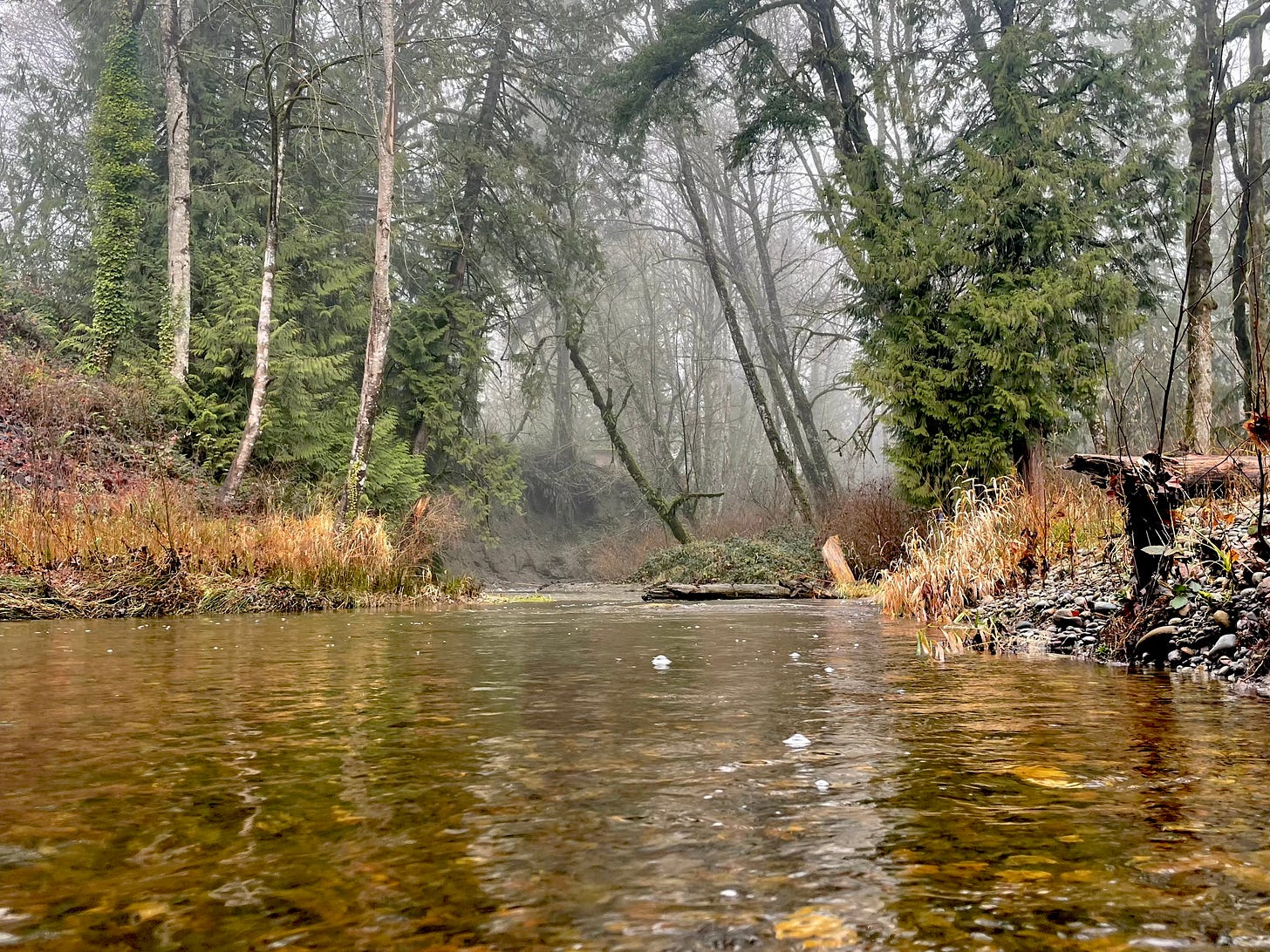Following Salmon Under the New Minter Creek Bridge
An expedition to give my community a taste of what lies beneath a bridge we cross all the time
“This is crazy,” Amy Amos keeps saying as we wade up Little Minter Creek, stepping over logs and bundles of willow branches until we are directly under the Key Peninsula Highway, where the creek bed is half missing.
I’m thinking the same thing but for a different reason. I’ve been in this spot hundreds of times, thousands: taking the corners fast with my eyes on the rumble strip, a pickup hot on my tail. And here I am surrounded by salmon carcasses, eagles, ravens, riffles and pools. Highway noise plays second fiddle to the sound of water jumping through tangled wood.
I’ve come to see what lies beneath the highway project that had us all snarled up like ivy for the past three summers.
We started under the new bridge, where the main stem of Minter Creek flows from north to south. Amos is the project engineer. She has been working for the Washington State Department of Transportation for 30 years. While she describes the bridge footings, its span, the short summer window for in-creek work, I am drawn through recently planted native vegetation and spawned-out salmon bodies and decaying road trash to the water’s edge.
Sunlight glints. Here and there a boulder. Round river rock in tans, grays, and blues, stretching under a shimmering blanket of clear water. Upstream a clay bank under big leaning firs; downstream a jumble of logs. Minter Creek sings, calls out: I want to follow it beyond where it vanishes, to know its way of traversing the peninsula. Water, moving. Eagles rise into tree limbs with gobs of salmon.
Amos says it takes a creek three years to find its balance after a project like this. To her, this looks like it is well on its way. It’s when we turn up Little Minter that things get wacky.
The highway, from its intersection with 118th to the bridge, follows Little Minter’s original shallow gully. It once crossed a wooden trestle bridge. “It was on these funky little Jenga block foundations,” Amos says, “and we ran into those when we were excavating to put the bridge abutments in.” What followed the wooden trestle was hardly a bridge at all: the state infilled Little Minter’s gully and kept right on filling over Minter Creek too, leaving it a double barrel culvert. Little Minter was shoved into a permanent detour that crosses under the highway once near 118th, meanders, crosses under again, meanders again, and dumps into the main stem just north of the bridge. WSDOT found its original bed while excavating old fill.
So the recent project wasn’t just the bridge, it was replacing pipes in two locations with spacious underpasses for Little Minter.
All of this was mandated by the 2013 culvert injunction, which required the state to free its fish-bearing waters from road blockages. The Minter Creek project was designed in 2018 and began in 2019. According to Amos, 2018 may as well be the Jurassic in terms of creek restoration design. That to me is a testament to just how much is being learned in real time about river dynamics during this epic statewide effort. After Covid-induced delays, at the 11th hour state and tribal biologists stepped in to require the addition of large dead wood, boulders, and other natural elements to give the reborn Minter Creek more complexity.
Dead wood in particular has become a science unto itself. “That’s what you want to see for habitat,” says Amos, pointing to a 40-foot log that is half in and half out of the water. Behind it is a deep pool and fine sediment, around it an arc of faster water. “Differential,” she says.
Dead wood does far more, as described in a recent book by river biologist Ellen Wohl. I’ve been carrying it around for months — I finished it long ago; I just can’t get over casually flaunting a book called Dead Wood. Big logs catch bits of other wood and sediment, rapidly building riverside habitats that, fueled by the slow release of nutrients in the wood, support lush growth. Anchoring the creek, which wants to wander, such hard points are less likely to blow out in floods. They also concentrate creek invertebrates. Paired with the sheltered pools they create, they are perfect fish habitat.
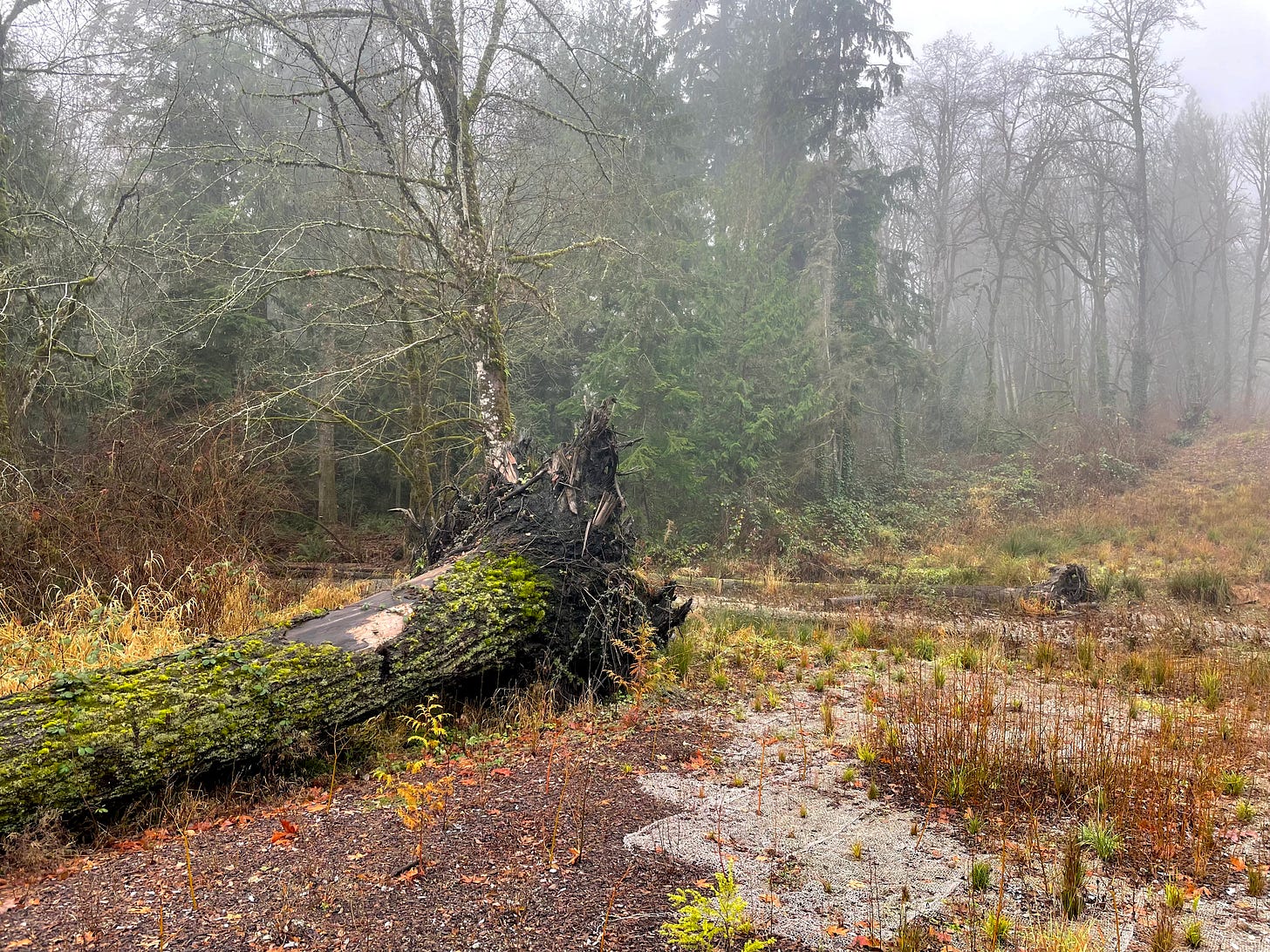
Are fish here? When state biologists swept the project area clean of fish, moving them just downstream, they found hundreds. One defishing in Little Minter caught and moved 34 resident cutthroat, 171 steelhead, 177 coho salmon, 63 chinook salmon, 121 sculpin, 40 sunfish, 17 lamprey, and 73 crayfish. (The salmonids were small juvenile fish.)
That’s not what is crazy to Amos, who has seen salmon return within a year to every culvert project she has engineered. As we wade up Little Minter to the second underpass, the creek is pitted with tangled branches, pools at odd angles, stranded coir logs and willow fascines. Leaves are plastered knee-high in the salmonberry tangles. A few weeks ago fell the biggest 24-hour rainfall in the last three years. Almost four inches.
The high water stripped at least two feet of rock and sand from the creek bed in the underpass. Shaking her head, Amos inspects the damage, the way the creek is finding its level.
The new method of river restoration uses bundles of buried slash, native plants, quick-rooting willow fascines, river rock, and big logs to sculpt a creek and fast-track it toward the flexibility that is inherent in nature and was ignored by the armored slopes of past engineering.
The irony, says Amos, is that there is not a drop of water in this stretch of Little Minter during the summer work window. Now I find a salmon tail sticking out of a mud deposit. The rest of the fish is buried.
For the third straight year, Amos’s team will have to return and shore things up. The essential challenge in this place is how two ways of being can coexist. The bridge and roadbed must stand fixed and strong against every semi-truck, wandering creek, and earthquake, while the creek must ebb, swell, jump, move, and rearrange itself if it is to preserve the secret to the life it sustains.
Later I return to Little Minter alone. The brush-pickers shack at the highway pullout may be gone, but I’m thinking that if any creek holds the spirit of the Key Peninsula it’s Little Minter: easy to discount, suddenly unruly, more complicated than you think. And crammed with life. Flipping river rocks I find countless damselfly larvae. Also a battery. Just upstream, heron tracks cross deer tracks on a sand bar. Which is another advantage of opening these creek underpasses. It’s not only salmon that need safe passage past roads.
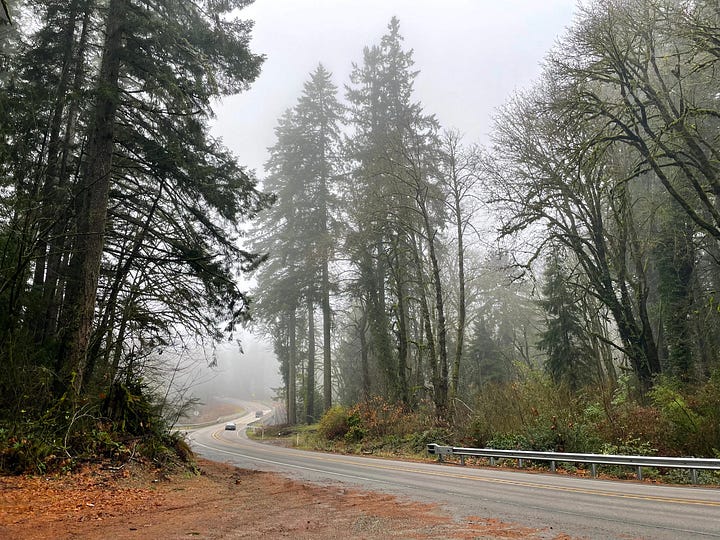

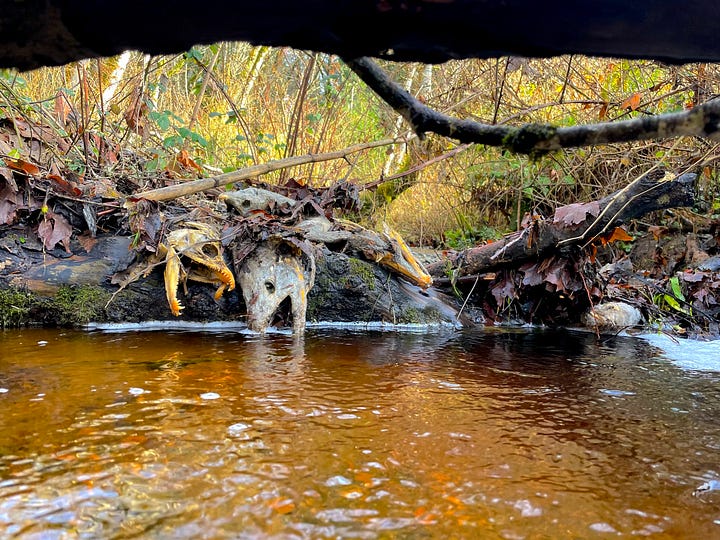
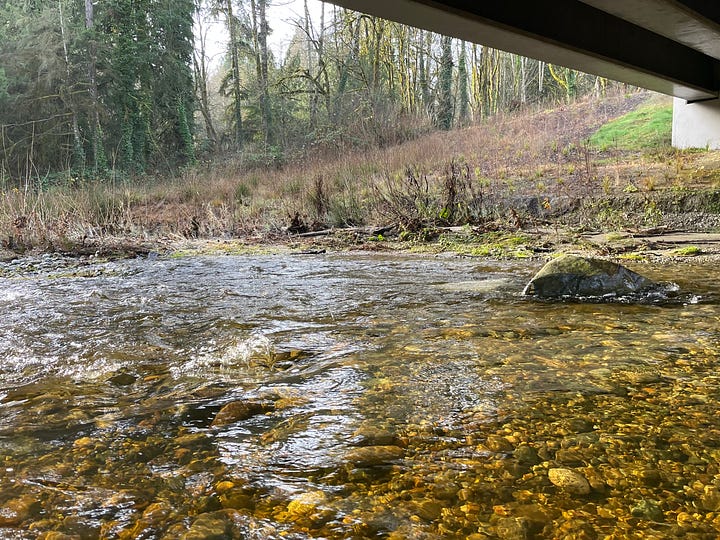
Thanks for joining me on this splash/tromp. Your support keeps me going. For more on the Infinite Peninsula and why I do what I do, see here.




